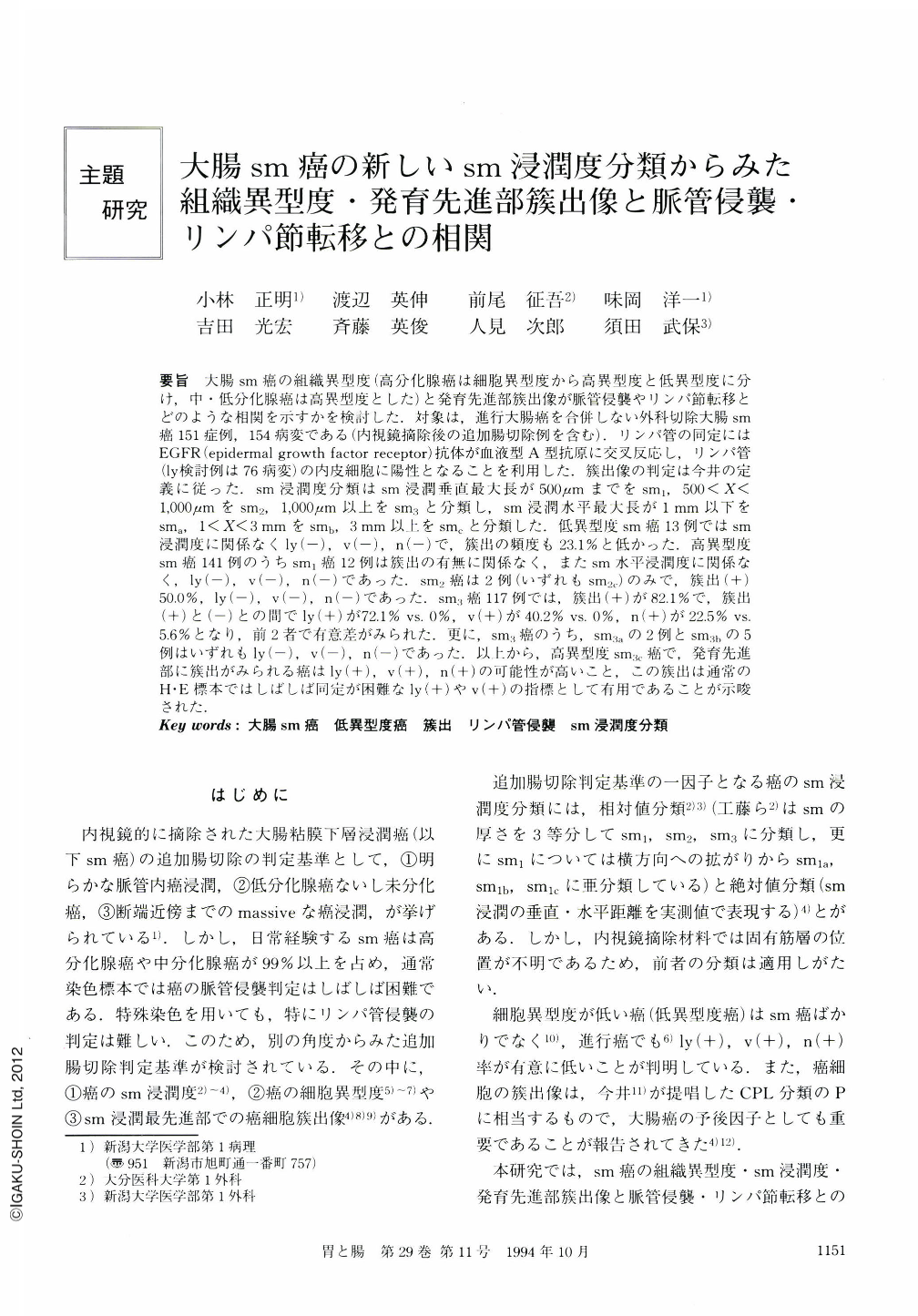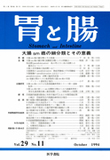Japanese
English
- 有料閲覧
- Abstract 文献概要
- 1ページ目 Look Inside
- サイト内被引用 Cited by
要旨 大腸sm癌の組織異型度(高分化腺癌は細胞異型度から高異型度と低異型度に分け,中・低分化腺癌は高異型度とした)と発育先進部簇出像が脈管侵襲やリンパ節転移とどのような相関を示すかを検討した.対象は,進行大腸癌を合併しない外科切除大腸sm癌151症例,154病変である(内視鏡摘除後の追加腸切除例を含む).リンパ管の同定にはEGFR(epidermal growth factor receptor)抗体が血液型A型抗原に交叉反応し,リンパ管(ly検討例は76病変)の内皮細胞に陽性となることを利用した.簇出像の判定は今井の定義に従った.sm浸潤度分類はsm浸潤垂直最大長が500μmまでをsm1,500<X<1,000μmをsm2,1,000μm以上をsm3と分類し,sm浸潤水平最大長が1mm以下をsma,1<X<3mmをsmb,3mm以上をsmcと分類した.低異型度sm癌13例ではsm浸潤度に関係なくly(-),v(-),n(-)で,簇出の頻度も23.1%と低かった.高異型度sm癌141例のうちsm1癌12例は簇出の有無に関係なく,またsm水平浸潤度に関係なく,ly(-),v(-),n(-)であった.sm2癌は2例(いずれもsm2c)のみで,簇出(+)50.0%,ly(-),v(-),n(-)であった.sm3癌117例では,簇出(+)が82.1%で,籏出(+)と(-)との間で1y(+)が72.1%vs.0%,v(+)が40.2%vs.0%,n(+)が22.5%vs.5.6%となり,前2者で有意差がみられた.更に,sm3癌のうち,sm3aの2例とsm3bの5例はいずれも1y(-),v(-),n(-)であった.以上から,高異型度sm3c癌で,発育先進部に簇出がみられる癌はly(+),v(+),n(+)の可能性が高いこと,この簇出は通常のH・E標本ではしばしば同定が困難なly(+)やv(+)の指標として有用であることが示唆された.
We studied 154 colorectal carcinomas, invading down to the submucosa, to evaluate the correlation of histological atypia and cancer-sprouting with vascular permeation and lymph nodal metastasis by our new histological classification of submucosal invasion. According to the criteria for cytologic grading by Watanabe et al, we divided well differentiated adenocarcinomas into two groups; cancers with low-grade atypia (CAL) and cancers with high-grade atypia (CAH). Moderately and poorly differentiated adenocarcinomas, and anaplastic carcinomas were grouped as CAH. Cancer-sprouting was defined as small cancer-cell nests composed of several cancer cells at the advancing margins in the submucosa. Venous permeation was verified by Victoria blue elastic fiber staining and lymphatic permeation by EGFR-immunostaining which shows cross-reaction for lymphatic endothelium of blood group A and AB patients. The grade of submucosal invasion was designated as follows: sm1; X≦500μm, sm2; 500<X<1,000μm, and sm3; X≧1,000μm by vertical length of cancer tissue in the submucosa, and sma; X≦1mm, smb; 1<X<3mm, and smc; X≧3mm by horizontal length of cancer tissue in the sumucosa.
None of the CALs (n=13) regardless of grade of submucosal invasion, and the sml,2-CAHs (n=14) showed either vascular permeation or lymph nodal metastasis (Table1, 2). In the sm3-CAHs (n=117) cancer-sprouting was positively related to vascular permeation (venous permeation; 40.2% vs. 0%, p<0.0002, lymphatic permeation; 72.1% vs. 0%, p<0.001) and lymph nodal metastasis (22.5% vs. 5.6%) (Table3). All of the sm3a-CAHs (n=2) and sm3b-CAHs (n=5), however, were negative for vascular permeation and nodal metastasis.
These results indicate that the histological atypia of colorectal cancers and their sprouting are useful parameters for predicting vascular permeation and lymph nodal metastasis, and that submucosal carcinomas of CAL or sm1,2-CAH or 94% of sm3-CAH without cancer-sprouting at the advancing margins do not need further surgery after endoscopic resection.

Copyright © 1994, Igaku-Shoin Ltd. All rights reserved.


